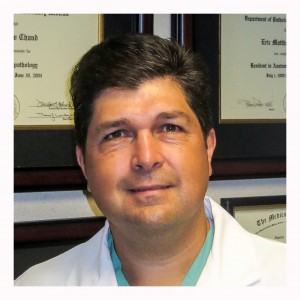Pathologist’s Corner – Dr. Eric Chand on Pancreatic Cancer
Published: June 8, 2015 – Dr. Eric Chand
 To understand pancreatic cancer, it helps to know about the normal pancreas and what it does. The pancreas lies between the stomach and the spine and is about 6 inches long. The wider end of the pancreas is called the head, the middle section is called the body, and the narrow end is called the tail. The head of the pancreas is on the right side of the abdomen (belly), behind where the stomach meets the duodenum (the first part of the small intestine). The body of the pancreas is behind the stomach, and the tail of the pancreas is on the left side of the abdomen next to the spleen.
To understand pancreatic cancer, it helps to know about the normal pancreas and what it does. The pancreas lies between the stomach and the spine and is about 6 inches long. The wider end of the pancreas is called the head, the middle section is called the body, and the narrow end is called the tail. The head of the pancreas is on the right side of the abdomen (belly), behind where the stomach meets the duodenum (the first part of the small intestine). The body of the pancreas is behind the stomach, and the tail of the pancreas is on the left side of the abdomen next to the spleen.
The pancreas is a gland and has two main functions: 1) to make juices that help digest (break down) food (exocrine pancreas cells) and 2) to make hormones, such as insulin and glucagon, that help control blood sugar levels. Both of these hormones help the body use and store the energy it gets from food. The hormones are made by endocrine pancreatic cells.
In up to 95% of cases, pancreatic cancer arises from the exocrine portion of the organ. The least common exocrine pancreatic cancer comes from acinar cells. Most of the exocrine tumors (~90%) are from ductal cells–those which line the pancreatic ducts. These tumors are classified as carcinomas, a word that refers to tumors arising from a lining cell. Further, under the microscope, the appearance and arrangement of these carcinoma cells can appear as duct-like (or “adeno”) giving the term adenocarcinoma to this most common form of pancreatic cancer.
About three-quarters of exocrine pancreatic cancer arises in the head and neck of the pancreas (the anatomic parts through which the pancreatic duct runs just before it meets the duodenum). Some of these carcinomas arise in the body of the pancreatic organ, and less than ten percent arise in the tail of the pancreas (the tapering smaller “left” area, closest to the spleen).
Generally, the diagnosis of early pancreatic cancer is very difficult. The most common symptoms of cancer of the pancreas include loss-of-appetite, weight loss, abdominal discomfort and nausea. As these are all fairly non-specific symptoms, there is often delay in getting to the final diagnosis. The most common physical sign of pancreatic cancer is jaundice, with or without associated itching. Proceeding to a medical evaluation often requires a high index of suspicion by the patient or by medical personnel who are experienced with the presentation of early pancreatic cancer.
Often lab results in pancreatic cancer show a high bilirubin and elevated liver function enzymes. The CA 19-9 marker is frequently elevated in pancreatic cancer. High CA 19-9 levels may tend to be associated with larger sized tumors and with a decreased likelihood of surgical resectability. The use of this marker is more universally accepted as a running measure within a particular individual (after diagnosis), to help reflect the stability, response, or progression of pancreatic cancer to treatment.
It is now understood that cancer is caused by the mutations of a gene which leads to increased abnormal cell growth. Genes in which this potential is directly conferred are called oncogenes. An oncogene called K-ras is found to be altered in up to 95% of ductal adenocarcinomas of the pancreas. Common known tumor-suppressor genes which are inactivated by mutation in this kind of pancreatic cancer are the p53 and p16 genes. For example, p53 is inactivated in about 70% of adenocarcinoms of the pancreas.
It has been approximated that up to 30% of the changes which initiate cancer of the pancreas are caused by smoking; and that about 10% are secondary to hereditary genetic predisposition. There appears to be a mild correlation between the onset of diabetes and pancreatic cancer, but it is not entirely clear if this is fully a cause or perhaps an effect of the cancer. There does not appear to be a strong correlation between the onset of pancreatic cancer and the drinking of alcohol or of coffee.
Cancers of the endocrine portion of the pancreas (neuroendocrine tumors) are less common than exocrine cancer of the pancreas – about two to three thousand cases are diagnosed each year in the U.S. They are typically referred to as neuroendocrine tumors – or otherwise known as islet cell tumors. Carcinoid tumors are a typically slow growing type of neuroendocrine tumor. Although they arise from the hormone producing area of the organ, neuroendocrine tumors can be either functioning (demonstrating excess hormone secretion which produces symptoms) or non-functioning. Endocrine tumors have a different natural history than the exocrine tumors. As a whole, they tend to be slower growing and have a better prognosis than standard pancreatic cancer. The treatment of neuroendocrine tumors of the pancreas is distinct from that of adenocarcinoma of the pancreas.
Each year more than 40,000 people in the United States are diagnosed with adenocarcinoma of the pancreas. Most of these people will have passed away by the end of the first year. The incidence of pancreatic cancer increases with age; most people are between the ages of 60 to 80 when they receive the diagnosis. Men have tended to be over-represented, though in recent years the gap between men and women has shrunk, possibly due to increased cigarette smoking among women. In the U.S., pancreatic cancer is 9th or 10th most commonly diagnosed cancer, but the fourth leading cause of cancer death in men and women. The median survival period from the time of diagnosis until demise is arguably the worst of any of the cancers. The median survival for untreated advanced cancer of the pancreas is about 3 1/2 months; with good treatment this increases to about six months, though many will live much longer.
References:
Pancreatic Cancer, American Cancer Society. 2014
Pancreatic Cancer, What you need to know. National Cancer Institute. 2014.
Pancreatic Cancer, PancreaticCa.org


